The Top Five Anti-Inflammatory Foods to Fight Flare Ups Naturally

By Chrissy Hayden, MS, CNS, LMT
March 3, 2021 • Digestion • Nutrition
The most frequently asked question I receive from my community is, “what are the best foods to eat to reduce pain and inflammation and what foods should I avoid?”
Before I dive in, I wanted to give a little back story on how I was able to improve my clients’ overall health once I started focusing on nutrition and gut health. If you have been around the block a few times with manual therapies, have test driven new medications, and are even seeing a personal trainer, this could be the missing link.
Or if you’re reading this and thinking, “my pain is the result of getting older,” or “it runs in my family,” I’m here to tell you, yes, those things could be true, but you have more power over your pain than you think and the research agrees!
The Missing Puzzle Piece
In my practice, clients would come in for clinical massage to reduce their muscle and joint pain. They were exercising, some with personal trainers, getting massages regularly, and even meditating.
But, when I would ask into their diets, I realized THIS was the missing puzzle piece.
Many of them were eating foods that were literally working against them, increasing inflammation in their body and contributing to pain. I also realized many of them had gut health issues, which were also pointing in the direction of pain and discomfort.
Once I started educating clients on eating for pain relief, healing their guts, and teaching them sustainable lifestyle habits to improve their muscle and joint health, the needle started to budge and this is when real change began to occur.
A Four-Pronged Approach to Pain Relief
After many years of sifting through the evidence and working with clients one-on-one, I formally developed a protocol that is based on a four-pronged approach to reducing joint pain.
The four prongs are:
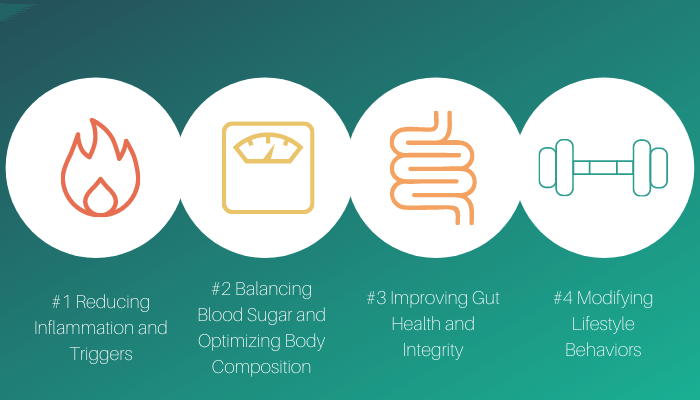
At the heart of most joint pain is chronic inflammation, which I’ll talk about in a minute, but what I want to point out is that balancing blood sugar, working on body composition, improving gut health, and tackling foundational lifestyle behaviors like sleep, stress management, movement, and social connection also play into inflammation indirectly!
Crazy, right?
It's never just about the joint in question. We have to look at the big picture and identify the root cause(s) in order to affect change for the long term. That’s what functional nutrition is all about.
Extinguishing the Flames
Today, we’re going to focus on the first prong, reducing inflammation using a food first approach! You may have heard of inflammation before. It’s your body’s natural response to injury or infection; however, when the immune system’s soldiers hang around longer than is necessary, this is called chronic inflammation and it plays a leading role in MOST of the conditions that cause muscle and joint pain.
The word arthritis literally means inflammation of the joints!
The cause of inflammation is slightly different depending on the condition, but if we’re looking at arthritis as an example, symptoms can be made worse if a person is eating a diet high in inflammatory foods, is obese or carries fat around their midsection, and lives a sedentary lifestyle.
In rheumatoid arthritis, our immune system often has trouble shutting off the little soldiers who fight off infection or other invaders and they begin attacking our joints. This actually causes more inflammation, damage to our connective tissue and a world of pain.
The same factors that exacerbate osteoarthritis or degenerative joint disease are the same for autoimmune, systemic inflammatory diseases like RA: diet and lifestyle.
So, all that to say, you can absolutely play a role in your body’s inflammatory response with your food choices!
Top Five Little Firefighters
Now that I’ve explained where food fits in to helping tame joint flare ups, let’s dive into the good stuff!
Here are my top five anti-inflammatory food recommendations:
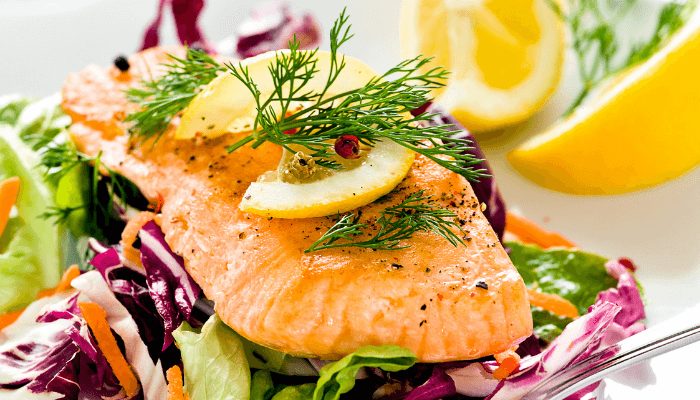
Wild Caught Salmon
Fat is your friend and one of your biggest allies in reducing pain. These cold water fatty fish are by far the most anti-inflammatory food out there, chock full of omega-3 fatty acids, which help to reduce inflammation (read: pain) in the body. They’re also rich in astaxanthin, which is a potent phytonutrient that makes salmon pink!
Always aim to eat as much color as possible throughout the day. I always joke that “Count colors, not calories” will be etched on my gravestone. Nutrient density is key when managing joint pain and inflammation, losing weight, healing your gut and improving your metabolic health.
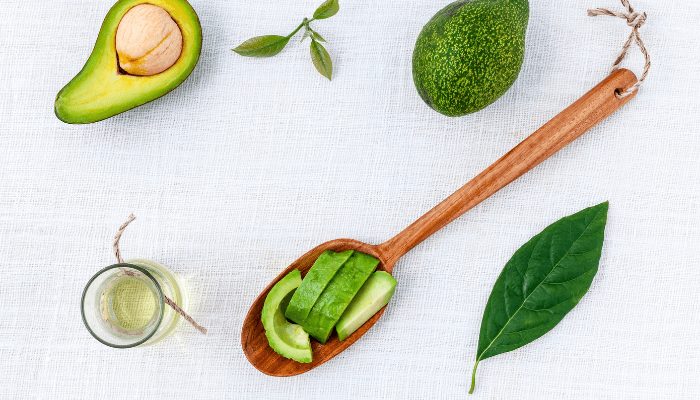
Avocados
Chock full of potassium, fiber and monounsaturated fats, avocados are major flame fighters when it comes to muscle and joint pain. One study comparing inflammatory markers in subjects who ate a plain hamburger versus one with half an avocado on top showed that the avocado-laden burger had less of an inflammatory effect on the participant than the hamburger alone!
That in and of itself is pretty amazing. My favorite combination of flavors is egg and avocado...I could literally eat this dynamic duo every single day. Another way I like to use avocados is guacamole! We eat tacos in our household once a week (sometimes on Tuesdays, haha).
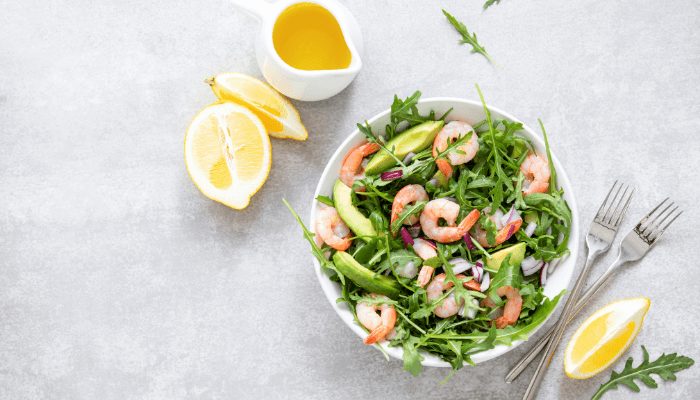
Leafy Greens
What do arugula, Swiss chard, romaine lettuce, kale, and spinach all have in common? They’re super rich in phytonutrients and vitamins A, C, and K, which protect cells from the damage caused by inflammation. Aim to eat at least two cups (pre-cooked because we know spinach wilts into about two tablespoons!) of green leafies per day.
I’ll dive into the importance of cellular health in a future blog post, but essentially, cells need three things to function optimally and the ability to protect itself is one of them. That’s where antioxidants come in and leafy greens are full of them.
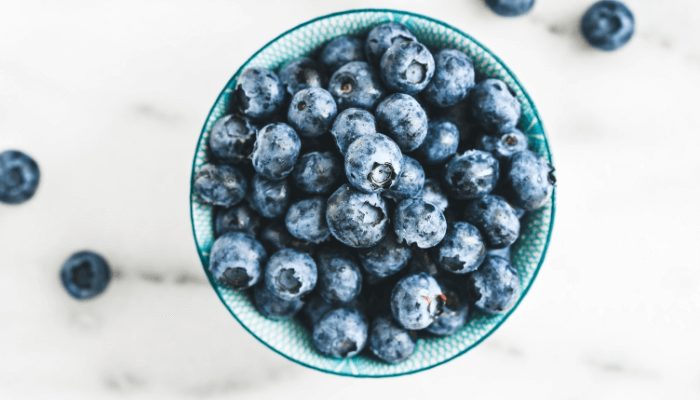
Berries
Berries are little powerhouses full of antioxidants that fight inflammation, reduce your risk of cancer, and protect your brain. They also make it easy to eat the rainbow with their varying colors of red, blue and black, which indicate the various phytonutrients they contain!
My favorite way to eat berries is frozen in a smoothie with coconut milk, spinach, almond butter, and collagen protein powder! I also love a snack of raspberries, brazil nuts, and almond flour crackers. However you enjoy them, know that they are providing your body with so much anti-inflammatory goodness!
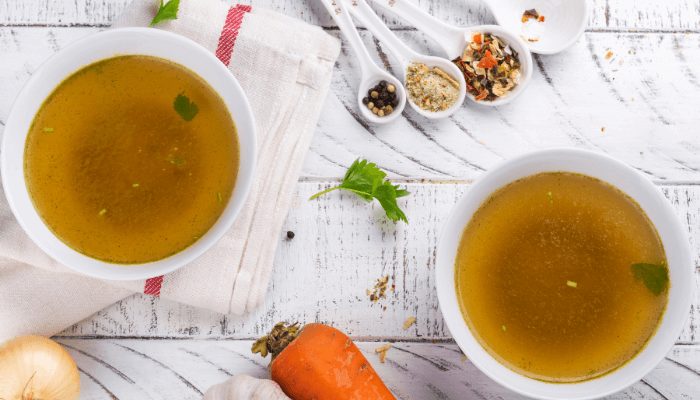
Bone Broth
Yes, I know it is all the rage to sip on bone broth these days, but for good reason!
Bone broth contains a type of protein called collagen that repairs and maintains our joint cartilage, skin, bones, nails and even our digestive lining. By maintaining the integrity of our connective tissue, we prevent inflammation from occurring by giving our bodies the building blocks needed to construct healthy tissue.
You can make your own bone broth from the carcass of a chicken, turkey, or leftover beef bones or buy it at your local health food store. I have no affiliations, but my favorite brand is found in the frozen section and it’s called Bonafide Provisions.
We sip on bone broth in mugs or use it as a base in soups in the colder months (aka right now!).
Top Five Known Offenders
Okay, so now that we’ve covered what foods you should eat, what about the ones you should minimize or eliminate?
Here is a quick and easy list of the top five offenders:
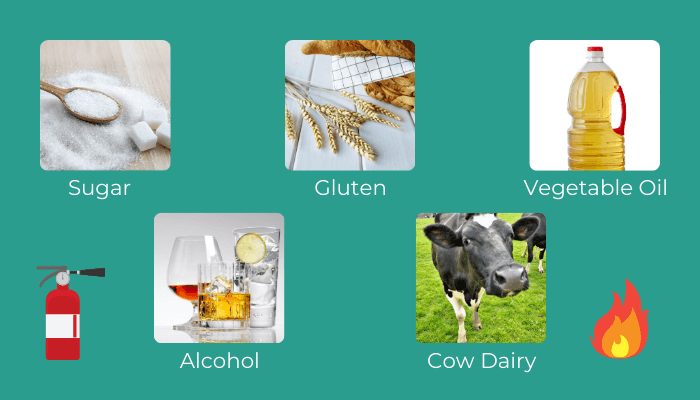
The foods above are known to fan the flames and cause flare ups in your muscles and joints. They can wreak havoc on your gut in varying ways and tip the scales toward inflammation due to the type of proteins and fats they contain.
I won’t get into the specifics for each of these foods in this blog post, but try to stay away from them if possible!
Want to Learn More?

If this type of information is exactly what you’ve been looking for, I invite you to join my upcoming masterclass, “The 3 Ways to Reduce Joint Pain Naturally for the Long Term!”
I've condensed my thirteen years of experience, two years of graduate studies, and months and months (and months!) of research into an hour-long class to show you:
- The root cause of most joint pain and why much of what is available in the conventional health field is only a band-aid fix
- A simple and straight forward way to learn your body's unique language, so you can make food choices that energize you and calm the flames
- The most frequent mindset hurdles my clients have faced when committing to turning the dial down for good and how to overcome them
- Plus a whole lot more...
Hope to see you there!
Leave a comment in the box below and let me know which of these fire fighting foods are your favorite! If you know of someone who could benefit from this info, feel free to share using the buttons below!
Chrissy Hayden is a functional nutritionist, massage therapist and owner of The Art of Health, LLC. Her primary focus is on helping women turn the dial down on joint pain using natural, evidence-informed interventions. Chrissy lives in Arlington, Virginia, with her husband and two little boys.
Let's Stay in Touch!
Sign up to receive tips, recipes and special offerings to support you in your wellness journey.
© 2025 The Art of Health, LLC
